Prototyping:3D & VR modellingProof of conceptPre-productionManufacture
Prototype manufacture
Being able to see, touch and functionally test a prototype before your product goes into production can really help you refine, demonstrate and sell the idea. During the product design development cycle we will make several prototypes at every stage. Prototypes range from very rough block models that show size and shape to accurate, fully representative models. Over the years we have made a wide variety of products from small hand-held items which we can do in house with our own 3D printing, through to complex mechanics in large scale machines, which we lean on the expertise of our very diverse network of professional prototyping services. We can help you make the right choices and manage the entire process for you, working with our UK-based and international partners.
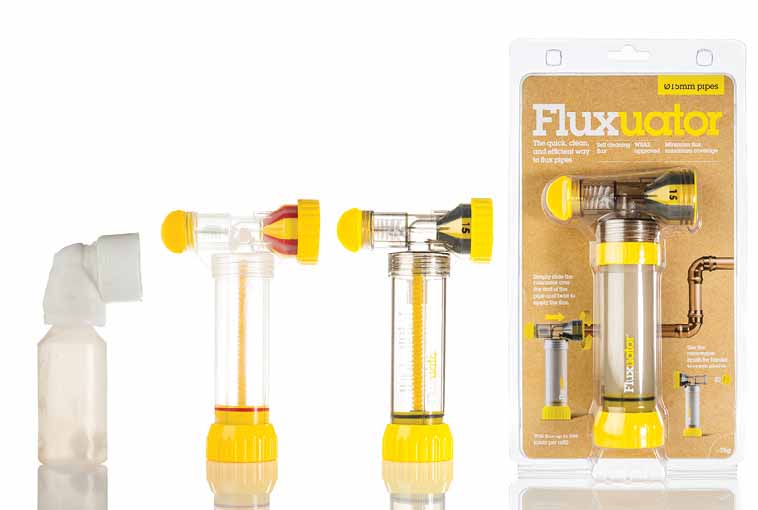
Overview
Prototyping is the single most important facet of design. It is done at every stage of development, from the initial brief through to pre-production sign off. We often get asked to “provide a cost of a prototype” and presented with a computer render or hand sketch of an idea.
To get from an idea through to a final prototype – representative of what will come off the production line - typically takes dozens of prototypes at various stages of development. Below we have detailed the different stages of prototyping to minimise risk and maximise product development efficiency, on the road to production.
For an example of the prototyping stages of a consumer product see our case study.
For prototyping an internet of things (IoT) product see our other case study.
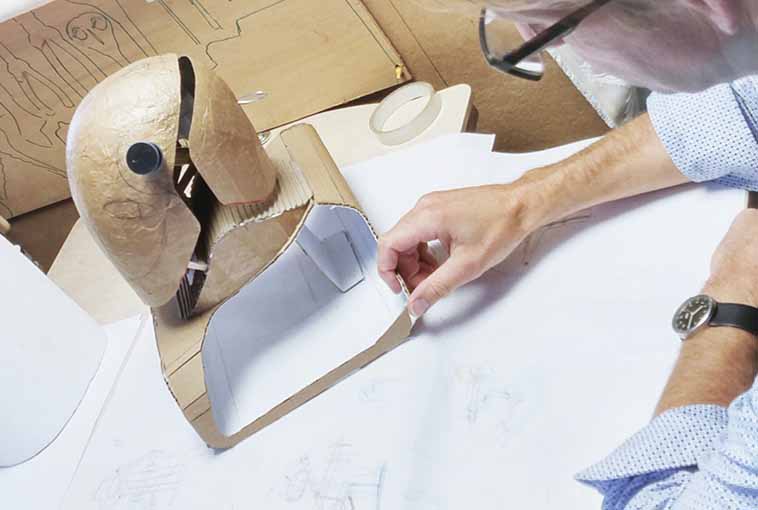
3D sketch modelling
From the very beginning when confirming the brief we will do a rough scale prototype. Often made in card, wood, blue tack, glue and scribbled on with sharpie markers. We call this stage – 3D sketching. It is amazing how often these 3d sketches change the brief. We sit with clients and crash out a 3d sketch to illustrate and clarify the thinking and the aim of a brief, and more often than not the client will say, “oh, actually, can it be…..”.
For the cost of an hour and some card these 3d sketches can save endless hours and money. The team at Google mocked up their fist prototype of the google glasses in less than an hour, by rigging a phone and some glasses with bits and bobs they had round the studio together so as everyone was on the same page and the design intent was clarified.
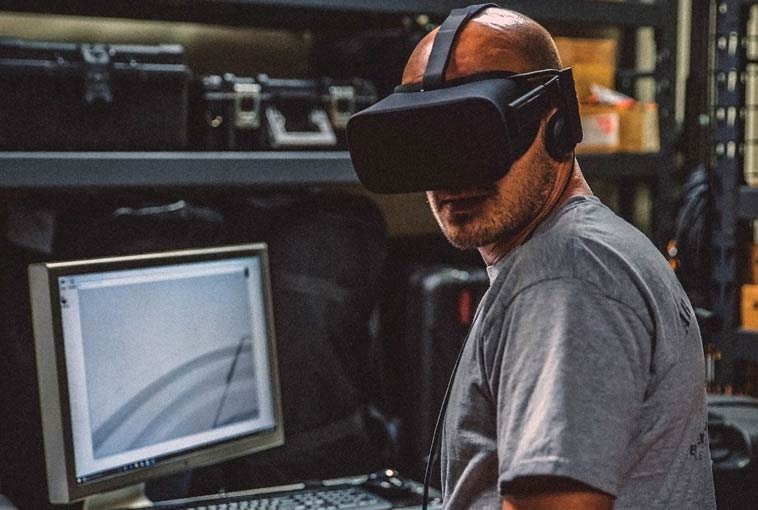
Virtual reality
Now that VR is so accessible, we often take our 3D sketches and mock them up to scale in block 3D cad and import that into VR programmes we use. We can then change the scale of the 3d virtual model and pretend using it, as well as blow it up in scale so we are the size of an ant, and we can crawl around the model.
We can split it out into component parts and see where we will have potential clashes or problems in manufacture. VR has proven to be a really efficient tool and is used in most of the design stages we work on.
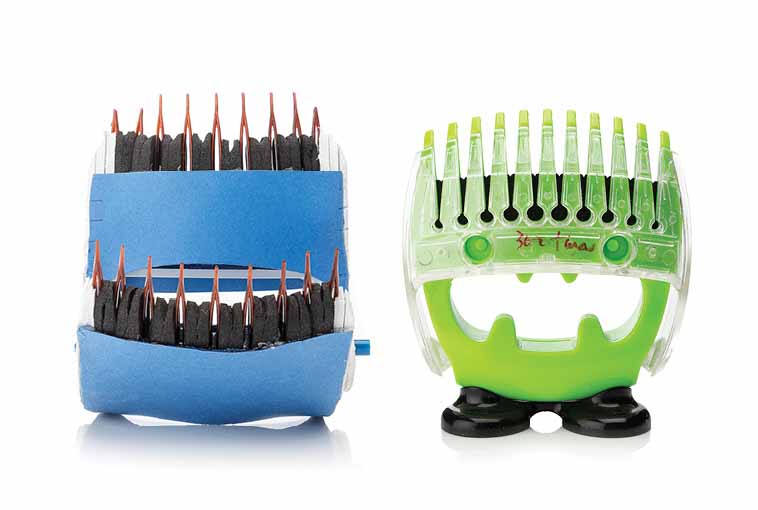
Proof of concept
A proof of concept model PoC is often the first stage 3D working prototype. No point engineering all the parts, this is the most expedient way to get to a model that proves a certain function. In most instances the products we design have several functions.
For example, our ice cream vending machine we have manufactured has several working concepts that need to combine for the machine to work as a whole. Each concept is split out and tested in as simple a rig as possible. We then go in and fine tune each rig- the emphasis is focusing on the end result – not on how it was achieved.
For more information about how we use 3D printing in our prototype stages see 'Product prototyping with 3D printing'.
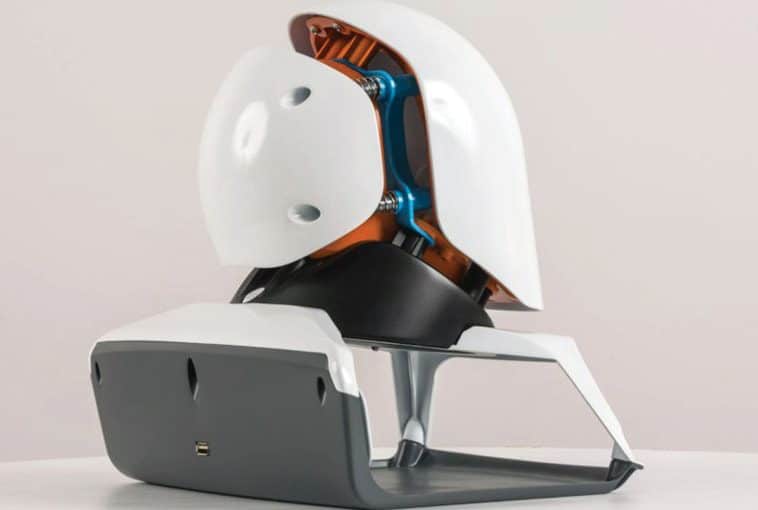
Works like, looks like (WLLL)
A works like, looks like prototype (WLLL) is often what people think is the first prototype we would develop. It is often impossible to do without having worked through the above stages first. As the name implies, it is a prototype that looks and functions like the final manufactured product. However it will not be made in production materials. Many of the products we have designed for market, such as our fluxuator, Hairmoji, FWIP require 3D printing as well as metal machine shop and electronic studio work.
As a studio we like to lean on our team in the machine shops, whether that be metal, wood or plastics. If you can machine it, you can more often than not manufacture it, whereas you can make anything with a 3D print but they can not be batch produced. The team in the machine shops use traditional mills and lathes as well as set of CNC machines. The parts are often as strong as we would achieve in production, which helps us progress the development more efficiently.
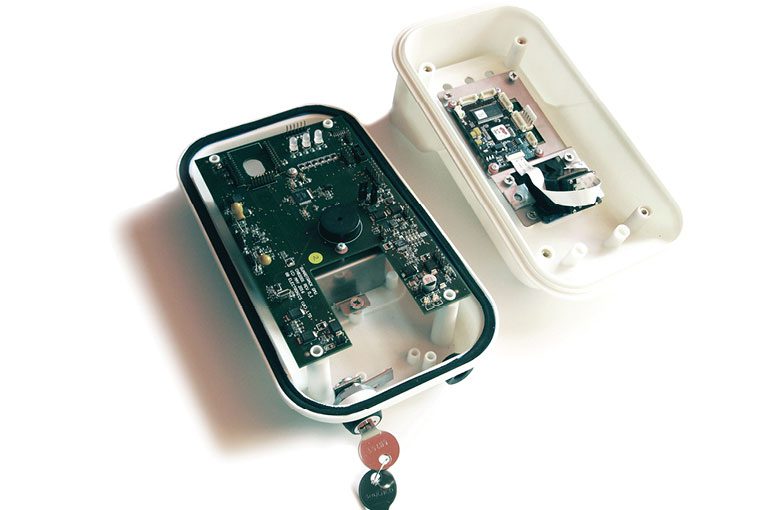
Pre-production
A pre production model is very similar to the WLLL, the only differences are that the manufacturing and production team have had their input on the design and have signed off that this is what they are happy to take to production. Sometimes the WLLL prototype will suffice, however quite often once the WLLL has been evaluated fully, we can see efficiencies for manufacture, or change elements that will enhance the user experience. These changes are reflected in a pre-production prototype we would ask the client to sign off.
Prototyping:3D & VR modellingProof of conceptPre-productionManufacture
Prototype manufacture
Being able to see, touch and functionally test a prototype before your product goes into production can really help you refine, demonstrate and sell the idea. During the product design development cycle we will make several prototypes at every stage. Prototypes range from very rough block models that show size and shape to accurate, fully representative models. Over the years we have made a wide variety of products from small hand-held items which we can do in house with our own 3D printing, through to complex mechanics in large scale machines, which we lean on the expertise of our very diverse network of professional prototyping services. We can help you make the right choices and manage the entire process for you, working with our UK-based and international partners.
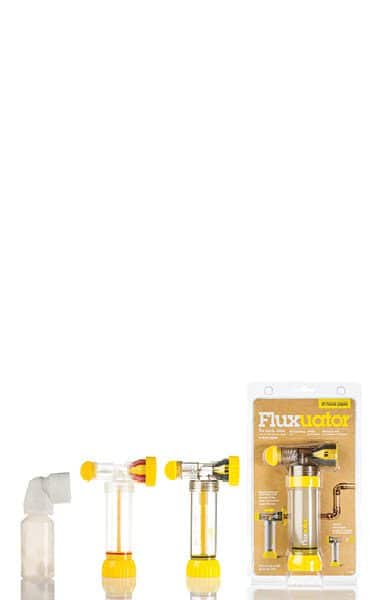
Overview
Prototyping is the single most important facet of design. It is done at every stage of development, from the initial brief through to pre-production sign off. We often get asked to “provide a cost of a prototype” and presented with a computer render or hand sketch of an idea.
To get from an idea through to a final prototype – representative of what will come off the production line - typically takes dozens of prototypes at various stages of development. Below we have detailed the different stages of prototyping to minimise risk and maximise product development efficiency, on the road to production.
For an example of the prototyping stages of a consumer product see our case study.
For prototyping an internet of things (IoT) product see our other case study.
3D sketch modelling
From the very beginning when confirming the brief we will do a rough scale prototype. Often made in card, wood, blue tack, glue and scribbled on with sharpie markers. We call this stage – 3D sketching. It is amazing how often these 3d sketches change the brief. We sit with clients and crash out a 3d sketch to illustrate and clarify the thinking and the aim of a brief, and more often than not the client will say, “oh, actually, can it be…..”.
For the cost of an hour and some card these 3d sketches can save endless hours and money. The team at Google mocked up their fist prototype of the google glasses in less than an hour, by rigging a phone and some glasses with bits and bobs they had round the studio together so as everyone was on the same page and the design intent was clarified.
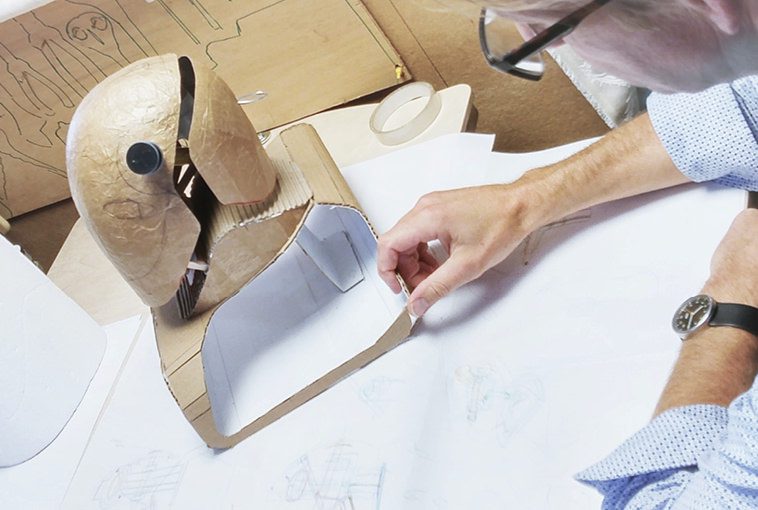
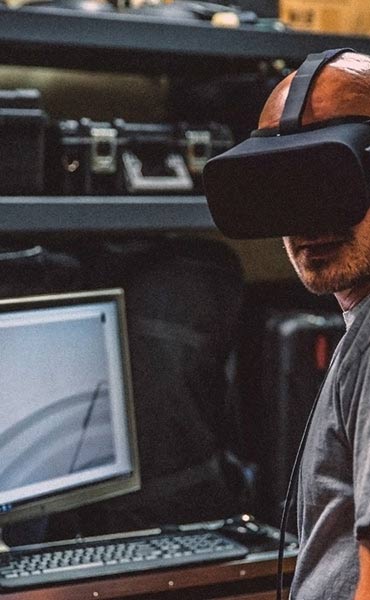
Virtual reality
Now that VR is so accessible, we often take our 3D sketches and mock them up to scale in block 3D cad and import that into VR programmes we use. We can then change the scale of the 3d virtual model and pretend using it, as well as blow it up in scale so we are the size of an ant, and we can crawl around the model.
We can split it out into component parts and see where we will have potential clashes or problems in manufacture. VR has proven to be a really efficient tool and is used in most of the design stages we work on.
Proof of concept
A proof of concept model PoC is often the first stage 3D working prototype. No point engineering all the parts, this is the most expedient way to get to a model that proves a certain function. In most instances the products we design have several functions.
For example, our ice cream vending machine we have manufactured has several working concepts that need to combine for the machine to work as a whole. Each concept is split out and tested in as simple a rig as possible. We then go in and fine tune each rig- the emphasis is focusing on the end result – not on how it was achieved.
For more information about how we use 3D printing in our prototype stages see 'Product prototyping with 3D printing'.
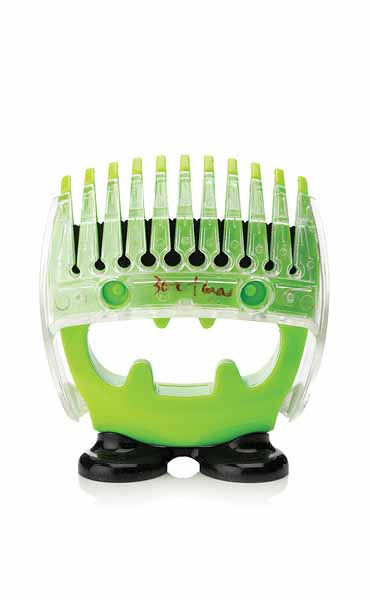
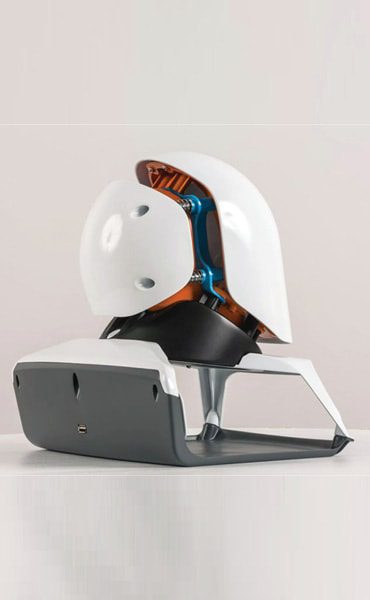
Works like, looks like (WLLL)
A works like, looks like prototype (WLLL) is often what people think is the first prototype we would develop. It is often impossible to do without having worked through the above stages first. As the name implies, it is a prototype that looks and functions like the final manufactured product. However it will not be made in production materials. Many of the products we have designed for market, such as our fluxuator, Hairmoji, FWIP require 3D printing as well as metal machine shop and electronic studio work.
As a studio we like to lean on our team in the machine shops, whether that be metal, wood or plastics. If you can machine it, you can more often than not manufacture it, whereas you can make anything with a 3D print but they can not be batch produced. The team in the machine shops use traditional mills and lathes as well as set of CNC machines. The parts are often as strong as we would achieve in production, which helps us progress the development more efficiently.
Pre-production
A pre production model is very similar to the WLLL, the only differences are that the manufacturing and production team have had their input on the design and have signed off that this is what they are happy to take to production. Sometimes the WLLL prototype will suffice, however quite often once the WLLL has been evaluated fully, we can see efficiencies for manufacture, or change elements that will enhance the user experience. These changes are reflected in a pre-production prototype we would ask the client to sign off.
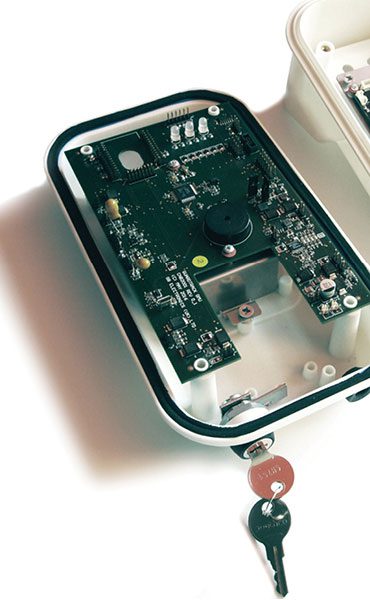
Prototyping:3D & VR modellingProof of conceptPre-productionManufacture
Prototype manufacture
Being able to see, touch and functionally test a prototype before your product goes into production can really help you refine, demonstrate and sell the idea. During the product design development cycle we will make several prototypes at every stage. Prototypes range from very rough block models that show size and shape to accurate, fully representative models. Over the years we have made a wide variety of products from small hand-held items which we can do in house with our own 3D printing, through to complex mechanics in large scale machines, which we lean on the expertise of our very diverse network of professional prototyping services. We can help you make the right choices and manage the entire process for you, working with our UK-based and international partners.

Overview
Prototyping is the single most important facet of design. It is done at every stage of development, from the initial brief through to pre-production sign off. We often get asked to “provide a cost of a prototype” and presented with a computer render or hand sketch of an idea.
To get from an idea through to a final prototype – representative of what will come off the production line - typically takes dozens of prototypes at various stages of development. Below we have detailed the different stages of prototyping to minimise risk and maximise product development efficiency, on the road to production.
For an example of the prototyping stages of a consumer product see our case study.
For prototyping an internet of things (IoT) product see our other case study.
3D sketch modelling
From the very beginning when confirming the brief we will do a rough scale prototype. Often made in card, wood, blue tack, glue and scribbled on with sharpie markers. We call this stage – 3D sketching. It is amazing how often these 3d sketches change the brief. We sit with clients and crash out a 3d sketch to illustrate and clarify the thinking and the aim of a brief, and more often than not the client will say, “oh, actually, can it be…..”.
For the cost of an hour and some card these 3d sketches can save endless hours and money. The team at Google mocked up their fist prototype of the google glasses in less than an hour, by rigging a phone and some glasses with bits and bobs they had round the studio together so as everyone was on the same page and the design intent was clarified.


Virtual reality
Now that VR is so accessible, we often take our 3D sketches and mock them up to scale in block 3D cad and import that into VR programmes we use. We can then change the scale of the 3d virtual model and pretend using it, as well as blow it up in scale so we are the size of an ant, and we can crawl around the model.
We can split it out into component parts and see where we will have potential clashes or problems in manufacture. VR has proven to be a really efficient tool and is used in most of the design stages we work on.
Proof of concept
A proof of concept model PoC is often the first stage 3D working prototype. No point engineering all the parts, this is the most expedient way to get to a model that proves a certain function. In most instances the products we design have several functions.
For example, our ice cream vending machine we have manufactured has several working concepts that need to combine for the machine to work as a whole. Each concept is split out and tested in as simple a rig as possible. We then go in and fine tune each rig- the emphasis is focusing on the end result – not on how it was achieved.
For more information about how we use 3D printing in our prototype stages see 'Product prototyping with 3D printing'.


Works like, looks like (WLLL)
A works like, looks like prototype (WLLL) is often what people think is the first prototype we would develop. It is often impossible to do without having worked through the above stages first. As the name implies, it is a prototype that looks and functions like the final manufactured product. However it will not be made in production materials. Many of the products we have designed for market, such as our fluxuator, Hairmoji, FWIP require 3D printing as well as metal machine shop and electronic studio work.
As a studio we like to lean on our team in the machine shops, whether that be metal, wood or plastics. If you can machine it, you can more often than not manufacture it, whereas you can make anything with a 3D print but they can not be batch produced. The team in the machine shops use traditional mills and lathes as well as set of CNC machines. The parts are often as strong as we would achieve in production, which helps us progress the development more efficiently.
Pre-production
A pre production model is very similar to the WLLL, the only differences are that the manufacturing and production team have had their input on the design and have signed off that this is what they are happy to take to production. Sometimes the WLLL prototype will suffice, however quite often once the WLLL has been evaluated fully, we can see efficiencies for manufacture, or change elements that will enhance the user experience. These changes are reflected in a pre-production prototype we would ask the client to sign off.




